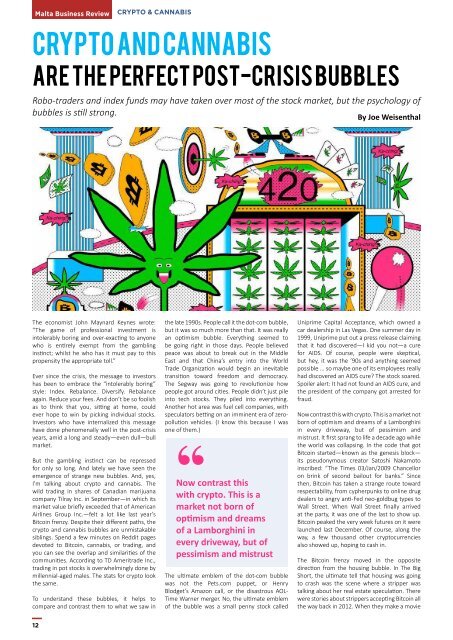MBR Issue 45
You also want an ePaper? Increase the reach of your titles
YUMPU automatically turns print PDFs into web optimized ePapers that Google loves.
Malta Business Review<br />
CRYPTO & CANNABIS<br />
Crypto and Cannabis<br />
Are the Perfect Post-Crisis Bubbles<br />
Robo-traders and index funds may have taken over most of the stock market, but the psychology of<br />
bubbles is still strong.<br />
By Joe Weisenthal<br />
The economist John Maynard Keynes wrote:<br />
“The game of professional investment is<br />
intolerably boring and over-exacting to anyone<br />
who is entirely exempt from the gambling<br />
instinct; whilst he who has it must pay to this<br />
propensity the appropriate toll.”<br />
Ever since the crisis, the message to investors<br />
has been to embrace the “intolerably boring”<br />
style: Index. Rebalance. Diversify. Rebalance<br />
again. Reduce your fees. And don’t be so foolish<br />
as to think that you, sitting at home, could<br />
ever hope to win by picking individual stocks.<br />
Investors who have internalized this message<br />
have done phenomenally well in the post-crisis<br />
years, amid a long and steady—even dull—bull<br />
market.<br />
But the gambling instinct can be repressed<br />
for only so long. And lately we have seen the<br />
emergence of strange new bubbles. And, yes,<br />
I’m talking about crypto and cannabis. The<br />
wild trading in shares of Canadian marijuana<br />
company Tilray Inc. in September—in which its<br />
market value briefly exceeded that of American<br />
Airlines Group Inc.—felt a lot like last year’s<br />
Bitcoin frenzy. Despite their different paths, the<br />
crypto and cannabis bubbles are unmistakable<br />
siblings. Spend a few minutes on Reddit pages<br />
devoted to Bitcoin, cannabis, or trading, and<br />
you can see the overlap and similarities of the<br />
communities. According to TD Ameritrade Inc.,<br />
trading in pot stocks is overwhelmingly done by<br />
millennial-aged males. The stats for crypto look<br />
the same.<br />
To understand these bubbles, it helps to<br />
compare and contrast them to what we saw in<br />
the late 1990s. People call it the dot-com bubble,<br />
but it was so much more than that. It was really<br />
an optimism bubble. Everything seemed to<br />
be going right in those days. People believed<br />
peace was about to break out in the Middle<br />
East and that China’s entry into the World<br />
Trade Organization would begin an inevitable<br />
transition toward freedom and democracy.<br />
The Segway was going to revolutionize how<br />
people got around cities. People didn’t just pile<br />
into tech stocks. They piled into everything.<br />
Another hot area was fuel cell companies, with<br />
speculators betting on an imminent era of zeropollution<br />
vehicles. (I know this because I was<br />
one of them.)<br />
"Now contrast this<br />
with crypto. This is a<br />
market not born of<br />
optimism and dreams<br />
of a Lamborghini in<br />
every driveway, but of<br />
pessimism and mistrust<br />
The ultimate emblem of the dot-com bubble<br />
was not the Pets.com puppet, or Henry<br />
Blodget’s Amazon call, or the disastrous AOL-<br />
Time Warner merger. No, the ultimate emblem<br />
of the bubble was a small penny stock called<br />
Uniprime Capital Acceptance, which owned a<br />
car dealership in Las Vegas. One summer day in<br />
1999, Uniprime put out a press release claiming<br />
that it had discovered—I kid you not—a cure<br />
for AIDS. Of course, people were skeptical,<br />
but hey, it was the ’90s and anything seemed<br />
possible ... so maybe one of its employees really<br />
had discovered an AIDS cure? The stock soared.<br />
Spoiler alert: It had not found an AIDS cure, and<br />
the president of the company got arrested for<br />
fraud.<br />
Now contrast this with crypto. This is a market not<br />
born of optimism and dreams of a Lamborghini<br />
in every driveway, but of pessimism and<br />
mistrust. It first sprang to life a decade ago while<br />
the world was collapsing. In the code that got<br />
Bitcoin started—known as the genesis block—<br />
its pseudonymous creator Satoshi Nakamoto<br />
inscribed: “The Times 03/Jan/2009 Chancellor<br />
on brink of second bailout for banks.” Since<br />
then, Bitcoin has taken a strange route toward<br />
respectability, from cypherpunks to online drug<br />
dealers to angry anti-Fed neo-goldbug types to<br />
Wall Street. When Wall Street finally arrived<br />
at the party, it was one of the last to show up.<br />
Bitcoin peaked the very week futures on it were<br />
launched last December. Of course, along the<br />
way, a few thousand other cryptocurrencies<br />
also showed up, hoping to cash in.<br />
The Bitcoin frenzy moved in the opposite<br />
direction from the housing bubble. In The Big<br />
Short, the ultimate tell that housing was going<br />
to crash was the scene where a stripper was<br />
talking about her real estate speculation. There<br />
were stories about strippers accepting Bitcoin all<br />
the way back in 2012. When they make a movie<br />
12





